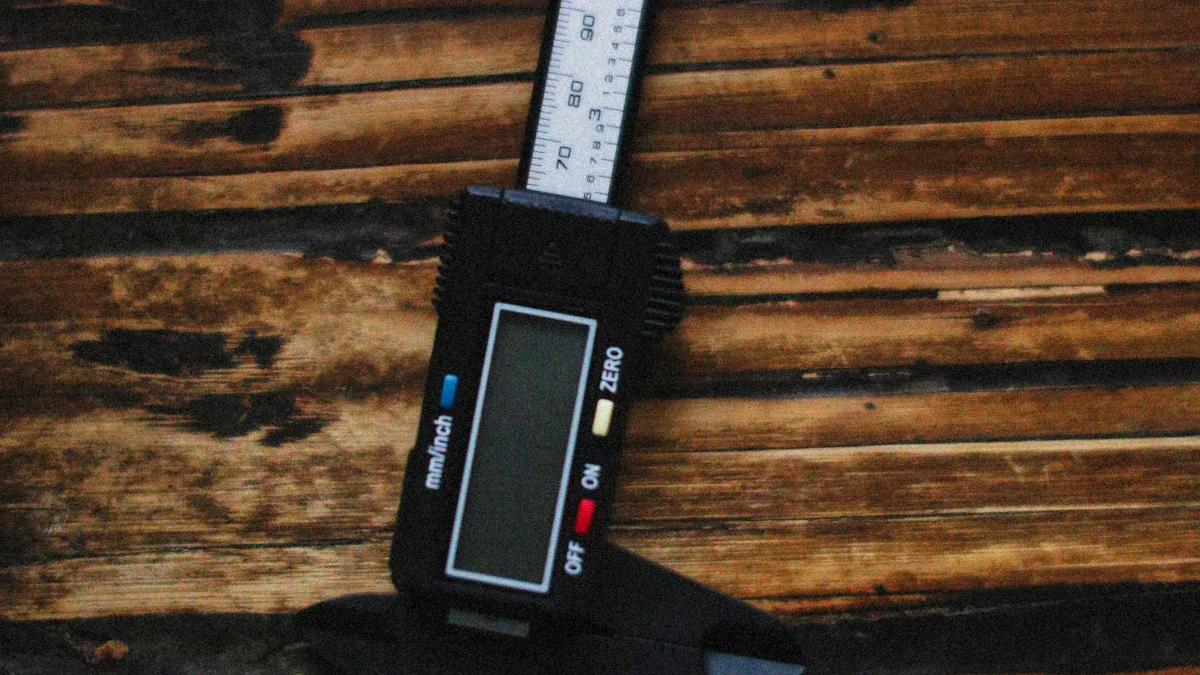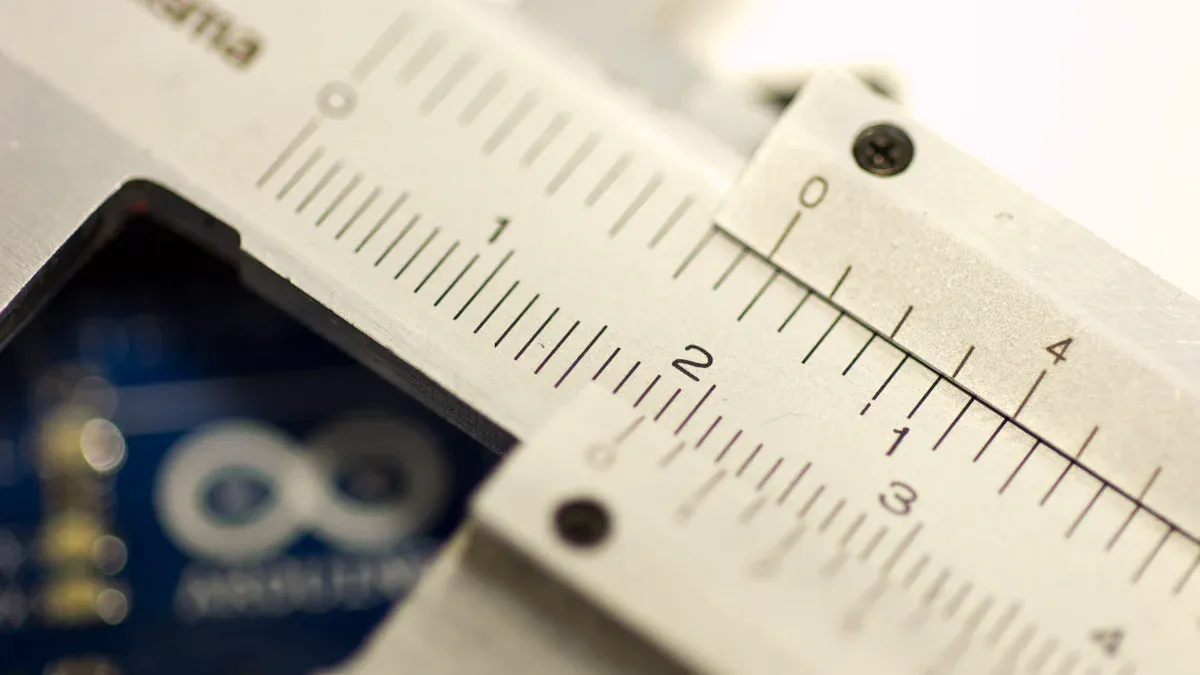- All
- Product Name
- Product Keyword
- Product Model
- Product Summary
- Product Description
- Multi Field Search
Views: 0 Author: Site Editor Publish Time: 2025-08-08 Origin: Site









If you want quick and easy measuring, a digital vernier caliper is the best choice. For something simple and strong, pick a traditional vernier caliper. Dial calipers are great if you prefer tools with moving parts and no batteries. Most experts now choose digital vernier calipers because they are fast and very accurate. The market for digital vernier calipers is growing rapidly:

Caliper Type | Best For |
|---|---|
Digital vernier calipers | Fast, precise measurements |
Dial calipers | Reliable, battery-free use |
Vernier calipers | Rugged, budget-friendly |
Consider what matters most to you. Do you want accuracy, ease of use, reliability, or affordability? The right caliper, especially a digital vernier caliper, will help every project go smoother.
Digital calipers give quick and easy measurements. They have features like changing units and sending data. These are good for hobbyists and professionals. People who want fast and correct results like them.
Dial calipers do not need batteries. They give smooth and steady readings with a clear dial. These are great for machinists and people who like analog tools. They work well in busy or oily places.
Vernier calipers are strong and last a long time. They do not need batteries. They are good for rough places and people who want a tool that lasts. You need to learn how to read them by hand.
All caliper types can be correct if you use them right. You must handle and set them up the right way. Pick the best one for your work, money, and what is easy for you.
Take care of your calipers by cleaning and storing them right. Check and set them often. Do not use them the wrong way. This will keep them working well and save you time and money.

Digital calipers are easy to use. You move the jaws, and the screen shows the number. You do not have to look at small lines or guess the pointer. You can change from inches to millimeters with a button. This is helpful if you use both units for projects. Most digital calipers use a special sensor, not gears. This makes them tougher than dial calipers if you drop them. Some digital calipers have IP67 ratings. This means they keep out dust and water. The best digital calipers give fast and correct results every time.
Feature | Benefit |
|---|---|
Digital display | Easy to read, no guessing |
Unit conversion | Switch between inches and millimeters |
Shock resistance | Less likely to break if dropped |
High resolution | Measures to 0.001 inch or 0.01 mm |
Data output | Connects to computers for records |
Digital calipers are very accurate, down to tiny amounts. The absolute digital caliper remembers its zero spot. You do not need to set it again each time. This saves time and helps you avoid mistakes.
Digital calipers need batteries to work. If the battery is dead, you cannot use them until you put in a new one. Dirt or water can sometimes make the numbers wrong, even if some models resist these problems. Cheap digital calipers may not last long or stay correct. You need to be careful with soft or bendy parts, or you might get a wrong number. Sometimes, you must lock the jaws to see the number better, especially for step checks. The absolute digital caliper helps, but you still need to check your work.
Tip: Keep your digital calipers clean and dry. Change the battery before it dies so you do not get stuck.
Digital calipers are great if you want fast and easy measuring. People who like hobbies, DIY, or machine work use them a lot. If you wear glasses or do not like small lines, these are the best choice. They work well in shops, schools, and at home. Many workers pick digital calipers because they trust the results and like the extra features. If you want to save time and avoid mistakes, pick a digital caliper.
You get a tool that works anytime. Dial calipers never need batteries. You just pick them up and start measuring. The dial face gives you a clear, quick reading. Many people find the analog display easy to understand. You see the pointer move as you slide the jaws. This makes it simple to spot small changes. The rack and pinion inside the caliper give you smooth, steady movement. You feel the precision in your hands. Many machinists trust dial calipers for this reason.
No batteries needed—always ready
Quick, easy-to-read dial face
Smooth, tactile feedback
Reliable for repetitive tasks
You can use these calipers in places where dirt or oil might stop a digital tool. They work well in busy shops or garages. You can zero the dial caliper fast. This helps you keep your work moving.
Dial calipers need careful handling. The gears inside can get dirty or damaged if you drop them. Dirt in the rack and pinion can make the caliper read wrong. You must keep it clean and store it safely. If you use it in a rough place, check the calibration often. The dial can slip out of place after a shock. You may need to fix or adjust it more than other calipers.
Caliper Type | Maintenance & Fragility Notes |
|---|---|
Dial Calipers | Sensitive to drops and dirt. Gears can get stuck. Needs regular cleaning and careful storage. |
Digital Calipers | Needs batteries. Can fail if wet. Moderate shock resistance. |
Vernier Calipers | Tough and shockproof. Needs little care. |
You might find that dial calipers cost more than basic vernier types. They do not like rough treatment. If you want a tool for harsh jobs, you may want to look at other calipers.
Dial calipers shine in busy shops and factories. You see them in automotive, aerospace, and metalworking work. Machinists love them for quick checks and steady results. You can use them for measuring engine parts, metal pieces, or even circuit boards. The dial caliper gives you fast, repeatable numbers. You do not worry about batteries dying in the middle of a job. If you want a tool that feels solid and gives you instant feedback, this caliper fits you best.
Tip: Wipe your calipers after each use. Store them in a case. This keeps them working smoothly for years.

You want a tool that lasts. Vernier calipers stand up to tough jobs. They use stainless steel or carbide, so you get a caliper that resists rust and wear. You can drop it, wipe off grease, or use it in a hot, dusty shop. It keeps working. Many models even block water and dust, so you do not worry about the environment. You do not need batteries. You just pick up your caliper and measure. Regular cleaning and calibration keep it accurate for years.
Stainless steel and carbide build for long life
Works in heat, cold, dust, or grease
No batteries or electronics to fail
Simple design means fewer parts to break
Tip: Wipe your caliper after each use. It will last even longer.
Reading a vernier caliper takes practice. You must line up the scales and avoid parallax error. Your eyes need to spot tiny marks. This makes the learning curve steeper than a digital vernier caliper or a dial caliper. You may need more time to get a measurement, especially if you are new. If you want fast results, a digital vernier caliper gives you numbers right away. Some people find the manual scale hard to read in low light or if their eyesight is not perfect.
Manual reading can slow you down
Needs good eyesight and steady hands
Steeper learning curve than digital vernier caliper
Not as quick for repeated checks
You see vernier calipers in many fields. Schools use them to teach measurement skills. Steel plants trust them for checking thickness and depth. Medical labs rely on them for precise work on instruments. Science labs use them for experiments, like measuring how metals expand. Aerospace teams need them for tiny, exact parts. You can use a digital vernier caliper for speed, but the classic caliper shines in rough places.
Field | Why Use a Vernier Caliper? |
|---|---|
Education | Teaches precision and measurement skills |
Steel Industry | Checks thickness and depth of tough materials |
Medical Sector | Measures surgical tools with high accuracy |
Science Labs | Tracks changes in metal and other experiments |
Aerospace | Ensures perfect fit for small, critical parts |
If you want a tool that works anywhere and lasts for years, a vernier caliper is your friend. You may switch to a digital vernier caliper for speed, but nothing beats the classic for pure toughness.
When you look at accuracy, all three calipers—digital, dial, and vernier—stand close together. Controlled tests show that each type can reach about ±0.001 inches for 0-6" calipers if you use and calibrate them right. Digital calipers often show more digits on the screen, but this does not always mean better accuracy. You still need to zero your tool and check it often. The ASME B89.1.14-2018 standard keeps accuracy levels the same for all types. If you want the best results, handle your calipers gently and calibrate them with known standards. You get reliable accuracy from any of these precision measurement tools when you care for them.
Digital calipers make life easy. You see numbers on a screen, switch units fast, and avoid reading tiny lines. The display helps you avoid mistakes, and the design feels good in your hand. Dial calipers give you a clear analog dial, which some people find quick to read. Vernier calipers take more skill. You must line up scales and read small marks. If you want speed and comfort, digital calipers win. Dial calipers come next. Vernier calipers need more practice, but you can master them with time.
Tip: If you use calipers all day, pick the type that feels best in your hand and gives you clear readings.
Durability matters when you use calipers in tough places. Vernier calipers have fewer moving parts. They last a long time and do not need batteries. You can drop them, and they keep working unless you really damage them. Dial calipers work well but can lose accuracy if you drop them. The gears inside may slip or get dirty. Digital calipers resist shock better than dial types, but they do not like water, oil, or dirt. Batteries can die, which stops your work. If you want a tool for rough jobs, vernier calipers are the best choice.
Caliper Type | Durability Notes |
|---|---|
Vernier | Tough, few moving parts, no battery, works in harsh spots |
Dial | Needs care, gears can slip, no battery, sensitive to drops |
Digital | Good shock resistance, needs battery, sensitive to water, oil, and dirt |
You want value from your calipers. Digital calipers cost more at first, but they save you time and give you features like data output. If you buy a high-quality model and take care of it, you spend less on repairs. Cheap digital calipers may break or give bad readings, so you end up buying new ones. Dial calipers cost less than digital calipers but need more care and can lose precision if you drop them. Vernier calipers have the lowest price, but you must keep them clean and check their accuracy. Over time, digital calipers give you the best value if you invest in a good one and maintain it.
Note: Always choose quality over price for calipers. Good tools last longer and keep your measurements true.
You want the right tool for your job. Calipers come in different types, and each one fits a different user. If you work in a busy shop or factory, you need a tool that gives you fast, accurate numbers. You may want features like data output or easy zeroing. If you work at home or in a school, you might care more about price and simple use.
Let's break it down:
Caliper Type | Best For | Why Choose It? |
|---|---|---|
Digital | Professionals, hobbyists, anyone needing quick, clear readings | Instant display, unit conversion, high accuracy, easy for poor eyesight |
Dial | Machinists, students, users who like analog tools | No batteries, smooth feel, easy to zero, reliable for repetitive tasks |
Vernier | Students, labs, rough environments, budget users | Durable, affordable, works anywhere, no batteries needed |
You might want digital calipers if you need to switch between inches and millimeters. They help you avoid mistakes and save time. If you wear glasses or want to avoid reading tiny lines, digital calipers make life easier. Some models even let you send data to a computer.
Dial calipers work well if you want a tool that never needs batteries. You get a smooth feel and a clear dial. Many machinists trust them for daily work. They handle repetitive checks and give you a solid grip.
Vernier calipers shine in tough places. You can drop them, wipe off grease, and keep going. They cost less and last for years. If you want to learn how to use calipers the old-school way, this type teaches you real measurement skills.
Tip: Think about where you will use your calipers. Dusty shops, wet labs, or clean classrooms all need different tools.
Here are some things to consider before you choose:
Do you need to measure in both inches and millimeters?
Will you use your calipers in a rough or clean place?
Do you want to avoid batteries?
Is price a big factor for you?
Do you need to record measurements on a computer?
Are you learning how to use calipers for the first time?
Professionals often pick digital calipers for speed and features. Hobbyists and students may choose dial or vernier calipers for price and durability. You get the best results when you match your needs to the right tool.
Many people make simple mistakes when picking calipers. You can avoid these problems if you know what to watch for.
Picking the wrong type for your work. Some users buy digital calipers for rough jobs, then find out they break or fail in dusty places.
Forgetting about batteries. Digital calipers stop working if the battery dies. Always keep a spare.
Ignoring calibration. All calipers need regular checks. If you skip this, your numbers may be wrong.
Using calipers for the wrong job. Never use them as a pry bar or screwdriver. This bends the jaws and ruins accuracy.
Not cleaning your tool. Dirt and oil can make calipers read wrong. Wipe them after each use.
Storing calipers in the wrong place. Keep them in a case, away from heat, dust, and magnets.
Forcing the jaws. If you push too hard, you can damage the tool or get a false reading.
Not learning how to use calipers properly. Rushing leads to mistakes. Take your time and practice.
Note: Many users regret not learning how to use calipers before starting a project. Practice on scrap material first.
Here's a quick checklist to help you avoid trouble:
Choose the right caliper for your environment.
Check batteries if you use digital calipers.
Clean and store your tool after each use.
Calibrate your calipers at least once a year.
Never force or drop your calipers.
Learn how to use calipers step by step.
If you follow these tips, your calipers will last longer and give you better results. You will spend less time fixing mistakes and more time getting your project done right.
There are different calipers for different people. Here is a simple chart:
User Type | Best Caliper |
|---|---|
Hobbyist | Digital |
Machinist | Dial |
Student/Lab | Vernier |
Digital calipers are good for quick and simple reading.
Dial calipers are best if you do not want batteries.
Vernier calipers are strong and last a long time.
Think about what you need most. Do you want your tool to be easy, exact, or tough? The right caliper will help you do your work better.
You read digital calipers on a screen. Dial calipers use a spinning dial. Vernier calipers have a sliding scale. Each type gives you measurements, but they look and feel different.
Yes! You can measure inside, outside, and even depth. Just use the right jaws or the depth rod. Most calipers work for all three types of measurements.
Wipe them after each use.
Store them in a case.
Check calibration once a year.
Never use them as a tool for prying.
Tip: Clean calipers last longer and stay true.
Home | Products | About KENDO | Distribution Network | Events | Contact Us